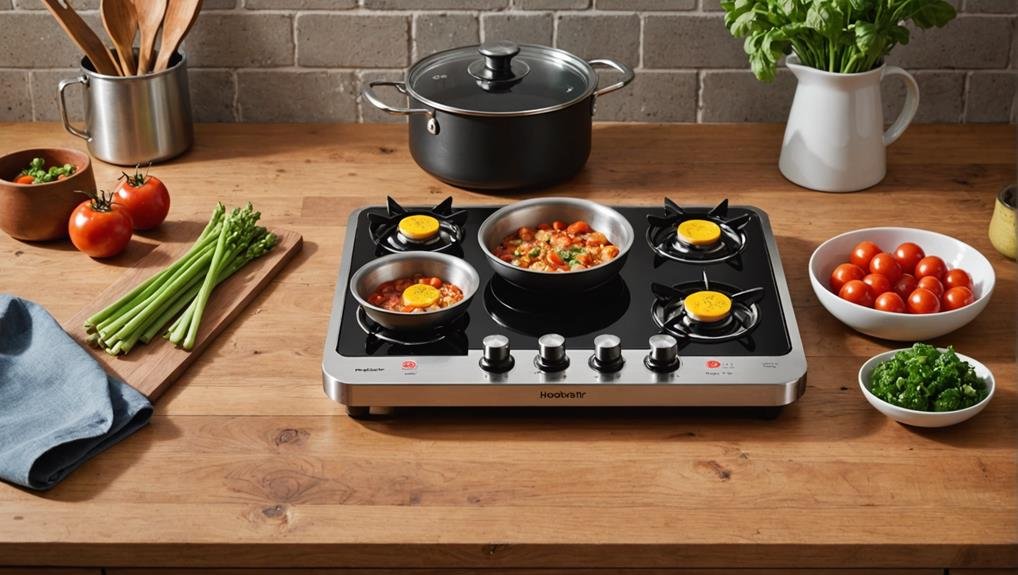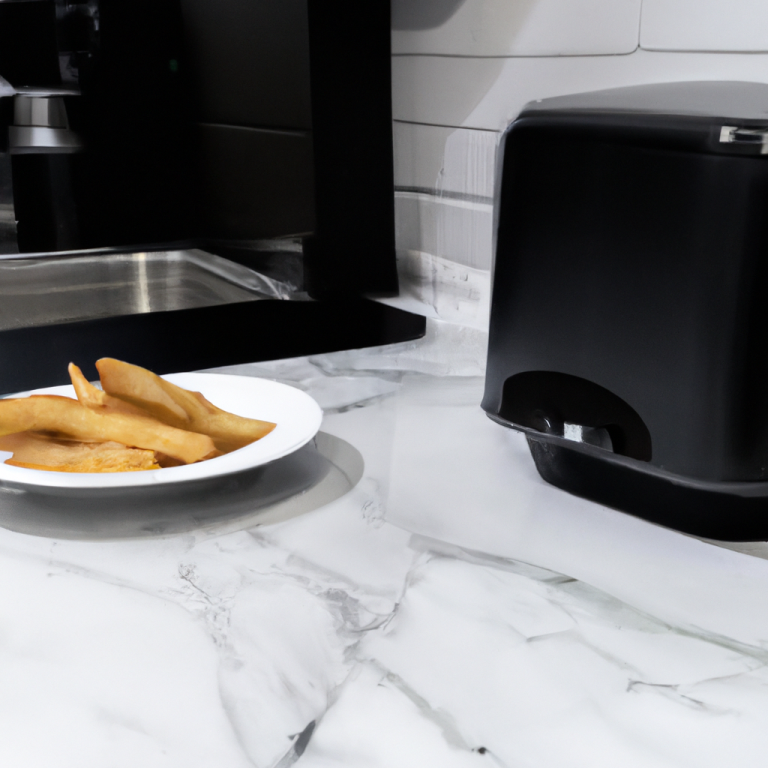When choosing a portable hob, several key features are crucial. First, prioritize safety features such as child locks and anti-overheating systems, which greatly reduce risks. Next, consider precise temperature control, allowing adjustments for different cooking methods. Power management is also essential, with wattage options offering efficient energy use. User-friendly controls, like intuitive touch panels, enhance the cooking experience. Additionally, versatility in design, including lightweight construction and multipurpose capabilities, caters to diverse needs. Finally, material quality affects heating efficiency and durability. Exploring these features guarantees the right choice for your cooking needs and preferences.
Safety Features
When evaluating portable hobs, safety features are paramount to guarantee a secure cooking environment. One significant aspect is child safety; many portable cooktops are equipped with child safety locks that prevent unintended operation, effectively ensuring that curious hands cannot accidentally activate the cooking surface. This feature is essential for families with young children, as it minimizes potential hazards in the kitchen.
Another important safety element is anti-overheating protection, which automatically shuts off the unit when it reaches dangerously high temperatures, minimizing fire risks. Additionally, anti-overflow safety systems are designed to cut power immediately when liquids overflow, preventing spills that could cause damage or hazardous situations.
Hot surface indicators serve as a visual reminder to users, often displayed as a red light, alerting them when the cooking surface remains hot after use.
Moreover, some models incorporate an automatic shut-off feature that activates after a period of inactivity, further reducing the risk of accidents. Together, these safety features not only enhance the functionality of portable hobs but also provide peace of mind, allowing users to focus on their culinary endeavors without undue concern.
Temperature Control
Effective temperature control is a vital feature to contemplate in portable hobs, particularly for those who value precision in their cooking.
Portable induction cooktops are designed to provide precise temperature control, enabling users to adjust the temperature within a single degree, which is fundamental for heat-and-hold situations and eliminates guesswork in food preparation.
Unlike gas cooktops, which depend on user feel, induction units offer enhanced accuracy, making them ideal for recipes that require specific cooking temperatures.
When evaluating portable hobs, consider the following aspects of temperature control:
- Direct Temperature Selection: Many models allow users to select exact temperatures for greater versatility.
- Wide Temperature Range: A broad range of temperature settings enhances the overall cooking experience, accommodating diverse recipes.
- Power Levels: The ability to adjust the temperature effectively guarantees consistent results.
- Maintaining Consistent Temperatures: This is essential for successful cooking, as fluctuations can lead to uneven results.
With these features, portable hobs can deliver the enhanced accuracy and reliable performance needed for effective induction cooking, making sure that your culinary endeavors yield successful outcomes every time.
Power Management
Power management is a critical aspect to evaluate in portable hobs, as it directly influences cooking efficiency and performance. Portable induction cooktops typically feature wattage capabilities ranging from 100 watts to 3700 watts, allowing for precise control over the cooking process. This versatility enables users to adjust temperature levels to suit various cooking needs, enhancing the overall culinary experience.
Standard electrical outlets usually support up to 1800 watts, which means that higher wattage induction cooktops may require dedicated circuits for peak performance. Unlike gas cooktops that often waste energy due to gas flow calibration, induction cooktops provide independent power control, promoting efficient power management.
Moreover, effective power distribution becomes essential when using multiple cooking zones simultaneously, preventing overload and ensuring consistent heating. Many portable hobs also incorporate overheating protection features, which safeguard the appliance and enhance user safety.
Additionally, the easy-to-clean surfaces of induction cooktops make them a practical choice for those who value convenience. By understanding the power management capabilities of portable hobs, consumers can make informed decisions that align with their cooking habits and energy efficiency goals.
User-Friendly Controls
A key aspect of enhancing the cooking experience with portable hobs lies in the user-friendly controls they offer. These controls are designed to facilitate seamless cooking, especially for novice chefs who may find traditional cooking methods intimidating.
Portable induction hobs typically feature intuitive touch controls and clear buttons, enabling quick adjustments to temperature settings without confusion.
Key features to look for in user-friendly controls include:
- Pre-set cooking functions that guide users on ideal temperature settings for common dishes.
- Responsive control systems that allow for precise temperature adjustments, often within a single degree for heat-and-hold situations.
- Angled control panels that minimize splatter, making them easily accessible while cooking.
- Comprehensive manuals that provide crucial information on wattage, cooking guidance, and troubleshooting tips, thereby enhancing the overall user experience.
These elements contribute notably to a more enjoyable cooking process, allowing users to focus on creativity rather than operational challenges.
Ultimately, the combination of user-friendly controls and thoughtful design makes portable hobs not only practical but also an invaluable asset in any kitchen.
Versatility in Design
The versatility in design of portable hobs greatly enhances their appeal and functionality in various culinary environments. These portable cooktops often combine aesthetics with practicality, catering to both front-of-house and back-of-house settings, thereby enriching the overall cooking experience.
Many models are lightweight and compact, making them ideal for shared living spaces, RVs, or temporary setups, allowing for effortless transportation and storage.
Moreover, some portable hobs feature dual-purpose designs that prioritize both durability and power, addressing diverse cooking needs without sacrificing visual appeal. For instance, angled control panels can help minimize splatter while maximizing the cooking surface, optimizing usability and counter space.
Another significant feature is the interchangeable nature of many portable hobs, which allows users to switch between gas, electric, and induction cooking methods. This flexibility meets varying user preferences and cooking requirements, ensuring that different culinary styles can be accommodated.
Material Quality
When selecting a portable hob, material quality plays a crucial role in determining cooking performance and overall user experience. The cooktop surface material directly influences heating speed, heat distribution, and safety during use.
For instance, tempered glass surfaces heat quickly, while stainless steel offers ease of cleaning and fast heating. On the other hand, die-cast metal surfaces provide superior heat retention, though they may heat more slowly, making them ideal for specific cooking styles.
When considering material quality, keep these key factors in mind:
- Induction Burners: Require ferromagnetic cookware for efficient heating.
- Enameled Cast Iron: Known for durability and excellent heat distribution.
- Gas Burners: Offer quick adjustments in heat, enhancing cooking control.
- Safety Features: Materials should minimize risks of burns or accidents.
Selecting the right material not only affects cooking performance but also impacts maintenance and safety.
For example, electric heating elements, typically covered by metal, take longer to heat up and cool down compared to induction surfaces. Consequently, careful consideration of these attributes guarantees a satisfactory cooking experience.
Bottom Line
In summary, selecting a portable hob necessitates careful consideration of essential features such as safety mechanisms, temperature control, power management, user-friendly controls, versatility in design, and material quality. Each of these elements contributes greatly to the overall functionality and reliability of the appliance. By evaluating these characteristics, users can guarantee that their choice meets both practical needs and safety standards, ultimately enhancing the cooking experience in various settings. A well-chosen portable hob can greatly facilitate culinary endeavors.



